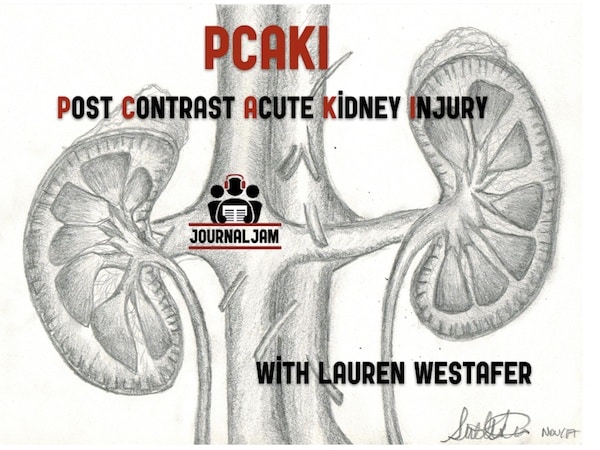Lauren Westafer joins Justin Morgenstern, Rory Spiegel and Anton Helman in a deep dive discussion on the world’s literature on Post Contrast Acute Kidney Injury (PCAKI) in this Journal Jam podcast. Hospitals continue to insist on time consuming and potentially dangerous protocols for administration of fluids to patients with renal dysfunction prior to CT IV contrast despite the lack of evidence that Contrast Induced Nephropathy (CIN) even exists. Would you choose a different imaging modality if your radiologist suggested that a patient with renal dysfunction who required a CT with IV contrast should forgo the contrast risking a missed diagnosis?
Podcast production by Justin Morgenstern, Rory Spiegel and Anton Helman, editing and sound design by Anton Helman,
Written summary by Anton Helman, November 2017
Cite this podcast as: Westafer, L, Morgenstern, J, Spiegel, R, Helman, A. Post Contrast Acute Kidney Injury – PCAKI. Emergency Medicine Cases. November, 2017. https://emergencymedicinecases.com/journal-jam-post-contrast-acute-kidney-injury-pcaki/. Accessed [date].
Key points on Post Contrast Acute Kidney Injury (PCAKI) discussed in this Journal Jam
- There is no consistent definition of PCAKI or CIN.
- There are no RCTs comparing IV contrast to placebo showing any significant difference in patient oriented outcomes.
- There are many confounding variables in all the studies to date.
- Anywhere from 1-20% of patients admitted to hospital will develop AKI whether or not they received IV contrast with 0.5% requiring dialysis.
- There are potential harms associated with foregoing IV contrast when it is indicated including missed diagnoses.
- Standardized preventative treatments such as normal saline administration, NAC and bicarb are not effective.
- Patients with a GFR <45 taking metformin have a theoretical risk of developing lactic acidosis. Multiple large reviews have not demonstrated any causal relationship. There is no increased risk of AKI in patients taking metformin.
EBM topics discussed in this Journal Jam
Take home message for Post Contrast Acute Kidney Injury
There is no reliable evidence that Contrast Induced Nephropathy exists. Patients who you believe require a CT scan with IV contrast should get one regardless of their renal function. Our attention should shift away from the IV contrast and toward ensuring that ED patients at risk for AKI do not receive nephrotoxic medications, have their fluid status assessed and attended to, and are counselled appropriately regarding their risk of AKI in hospital.
Articles Discussed in this Journal Jam on Post Contrast Acute Kidney Injury
Sandstede JJ, Roth A, Machann W, Kaupert C, Hahn D. Evaluation of the nephrotoxicity of iodixanol in patients with predisposing factors to contrast medium induced nephropathy referred for contrast enhanced computed tomography. European journal of radiology. 2007; 63(1):120-3.
Schmalfuss CM, Woodard PK, Gitter MJ. Incidence of acute kidney injury after intravenous administration of iodixanol for computed tomographic angiography. International journal of cardiology. 2014; 177(3):1129-30.
Lencioni R, Fattori R, Morana G, Stacul F. Contrast-induced nephropathy in patients undergoing computed tomography (CONNECT) – a clinical problem in daily practice? A multicenter observational study. Acta radiologica 2010; 51(7):741-50.
Newhouse JH, Kho D, Rao QA, Starren J. Frequency of serum creatinine changes in the absence of iodinated contrast material: implications for studies of contrast nephrotoxicity. American journal of roentgenology. 2008; 191(2):376-82.
Tremblay LN, Tien H, Hamilton P. Risk and benefit of intravenous contrast in trauma patients with an elevated serum creatinine. The Journal of trauma. 2005; 59(5):1162-6; discussion 1166-7.
Aulicky P, Mikulík R, Goldemund D, Reif M, Dufek M, Kubelka T. Safety of performing CT angiography in stroke patients treated with intravenous thrombolysis. Journal of neurology, neurosurgery, and psychiatry. 2010; 81(7):783-7.
Biondi-Zoccai G et al. Nephropathy after administration of iso-osmolar and low-osmolar contrast media: evidence from a network meta-analysis. International journal of cardiology. 2014; 172(2):375-80.
Heller M, Krieger P, Finefrock D, Nguyen T, Akhtar S. Contrast CT Scans in the Emergency Department Do Not Increase Risk of Adverse Renal Outcomes. The western journal of emergency medicine. 2016; 17(4):404-8.
Azzouz M, Rømsing J, Thomsen HS. Fluctuations in eGFR in relation to unenhanced and enhanced MRI and CT outpatients. European journal of radiology. 2014; 83(6):886-92.
McDonald RJ, McDonald JS, Carter RE. Intravenous contrast material exposure is not an independent risk factor for dialysis or mortality. Radiology. 273(3):714-25. 2014.
Davenport MS, Khalatbari S, Cohan RH, Dillman JR, Myles JD, Ellis JH. Contrast material- induced nephrotoxicity and intravenous low-osmolality iodinated contrast material: risk stratification by using estimated glomerular filtration rate. Radiology. 2013; 268(3):719-28.
Hinson JS, Ehmann MR, Fine DM. Risk of Acute Kidney Injury After Intravenous Contrast Media Administration. Annals of emergency medicine. 2017; 69(5):577-586.e4.
Update 2021: A well-powered cohort study and regression discontinuity analysis demonstrated no kidney dysfunction association with the use of IV contrast for CTPA. Abstract
Drs Helman, Morgenstern, Spiegel and Westafer have no conflicts of interest to declare
Other FOAMed Resources on PCAKI
First10EM Justin Morgenstern Does Contrast Cause Kidney Injury: The Evidence
FOAMCast Lauren Westafer Contrast Induced Nephropathy and Genitourinary Trauma
EMDocs Richard Sinert CIN Confounding Causation
RebelEM Salim Rezaie Is CIN Really Not a Thing?
PulmCrit Josh Farkus Do CT Scans Cause Contrast Nephropathy?





Leave A Comment